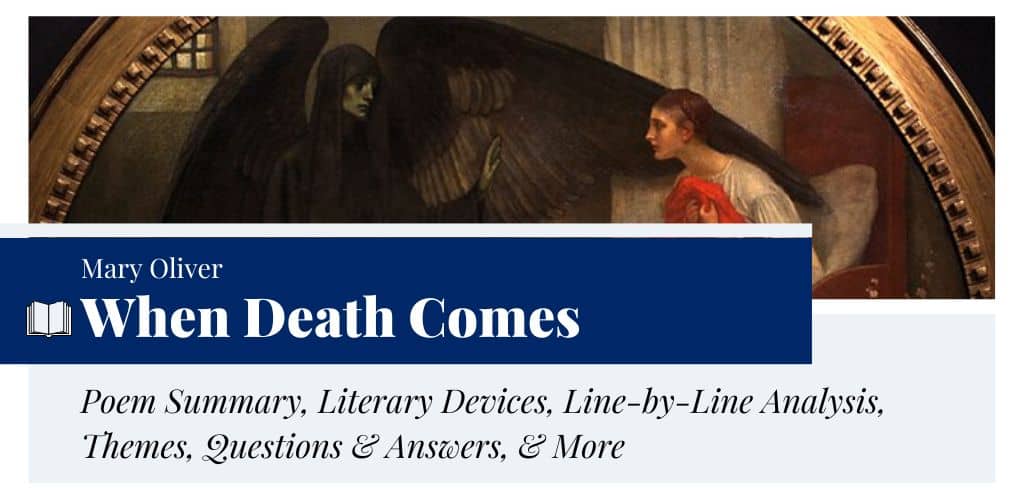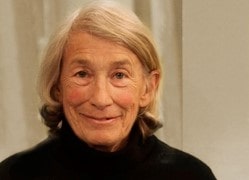When Death Comes by Mary Oliver
“When Death Comes” is one of Mary Oliver’s most remarkable poems originally published in New and Selected Poems (1992). It is a particularly impactful poem in which Oliver engages with the confusing and fearful subject of death. She does not take a conventional approach to death. Her existence becomes a perpetual phenomenon as death is no more an end event, but a destination, a “cottage of darkness,” she earnestly desires to visit. In this way, she also makes another claim that death is also a reminder of living life to the fullest and enjoying each and every moment no matter how ordinary it seems.
- Read the full text of “When Death Comes” below:
When Death Comes by Mary Oliver When death comes like the hungry bear in autumn; when death comes and takes all the bright coins from his purse to buy me, and snaps the purse shut; when death comes like the measle-pox when death comes like an iceberg between the shoulder blades, I want to step through the door full of curiosity, wondering: what is it going to be like, that cottage of darkness? And therefore I look upon everything as a brotherhood and a sisterhood, and I look upon time as no more than an idea, and I consider eternity as another possibility, and I think of each life as a flower, as common as a field daisy, and as singular, and each name a comfortable music in the mouth, tending, as all music does, toward silence, and each body a lion of courage, and something precious to the earth. When it's over, I want to say all my life I was a bride married to amazement. I was the bridegroom, taking the world into my arms. When it's over, I don't want to wonder if I have made of my life something particular, and real. I don't want to find myself sighing and frightened, or full of argument. I don't want to end up simply having visited this world. - from New and Selected Poems (1992)

Summary
“When Death Comes” begins with a description of what “death” is to Oliver. She uses vivid images that she draws from nature to form a semblance of death. There is an uncertainty that follows her thoughts throughout the poem, but she chooses to look forward to life’s rewarding journey as an integral part of her existence. She also looks at life as a collective experience even though one exists individually. It is death that unites all of humanity. Oliver uses a humanistic conclusion to her poem by bringing out her expectations from her own life before she departs for the final destination. She wants a life full of wonders. Besides, she wants to make a difference too. She does not want to be another visitor on this journey of life.
Structure & Form
“When Death Comes” is written in free-verse and there is no set rhyme scheme employed by Oliver. The diction remains simple and approachable, which gives this poem a stream-of-consciousness kind of feeling. Her thoughts seem to just go with the flow. The speaker of the poem is Oliver herself. The reader finds her meditating on life and death. Apart from that, the apparent simplicity of the poem does not by any means undermine the serious subject that it engages with. In fact, the free-verse form complements the poem’s seriousness, as well as, relaxed mood.
Literary Devices & Figurative Language
In “When Death Comes,” Oliver sprinkles a number of poetic devices across the text. These include:
Repetition
There is a constant use of repetition throughout the poem. Oliver uses the phrase “when death comes” a number of times in the opening to elicit emphasis. This phrase is repeated in lines 1, 3, 5, and 7:
When death comes
like the hungry bear in autumn;
when death comes and takes all the bright coins from his purse
–
to buy me, and snaps the purse shut;
when death comes
like the measle-pox
–
when death comes
like an iceberg between the shoulder blades,
There is also a repetition of the phrase, “When it’s over,” in lines 21 and 24. The last two lines end with the recurrence of the phrase, “I don’t want to,” at the beginning.
Imagery
Imagery is a poetic device that appeals to the sensory experience of the reader. Words are used to create pictures in readers’ minds. This poem is full of images plucked from nature that appeal to our eyes, more importantly, our minds. In the beginning, “death” is depicted with the use of nature imagery: “hungry bear in autumn,” “iceberg,” and “cottage.” The poet also uses the image of a trader who takes all the bright coins from his purse in order to buy the speaker. Besides, she uses auditory imagery in “snaps the purse shut” and tactile imagery in “iceberg between the shoulder blades.”
Simile
A simile is a literary device that establishes a direct comparison between two things. The comparison is made using “as” and “like.” There are a number of similes present in the poem that include: “like the hungry bear in autumn,” “like the measle-pox,” “like an iceberg between the shoulder blades,” “as a brotherhood and a sisterhood,” “and I consider eternity as another possibility,” “and I think of each life as a flower, as common/ as a field daisy, and as singular.
Symbolism
Oliver presents the concept of death as a place or a location. The “cottage of darkness” symbolizes “death” in the poem. She claims not only life to be a journey but also death too. She explains life to be like “comfortable music in the mouth,” which eventually leads to “silence” that implies “death.” So, life and death become inseparable as “music” and “silence” are.
Personification
Personification occurs when an inanimate idea is given human characteristics. In “When Death Comes,” Oliver personifies the concept of “death” as a human, who tries to buy her with his shining coins. The poet also personifies the abstract idea of “amazement” and the “world.” First, she compares herself to a “bride” married to the groom, “amazement.” Then, she becomes a “groom” and embraces the “world” as her bride:
When it’s over, I want to say all my life
I was a bride married to amazement.
I was the bridegroom, taking the world into my arms.
Line-by-Line Analysis & Explanation
Lines 1-4
When death comes
like the hungry bear in autumn;
when death comes and takes all the bright coins from his purse
–
to buy me, and snaps the purse shut;
Mary Oliver’s poem “When Death Comes” begins with a varied description of how “death” may appear and a meditation on the nature of death. This kind of pondering on the coming of death proves to be bold on the poet’s part. Oliver portrays the inevitability of death that at the same time is an unexpected calamity for humankind. She describes “death” using various images. It is compared to “the hungry bear in autumn.” This suggests an association with nature. Bears are portrayed as symbols of ferocity and steadfastness. Like a hungry bear prepares for the winter during fall, “death” hungrily awaits to devour its prey (humankind).
The act of dying is also compared to an exchange that is finalized between two individuals: one is the speaker and the other one is “death.” Death is commercialized through this image. With a “snap” of his purse, personified “death” makes a deal with the speaker. His only intention is to buy her life. This depiction of death is both shocking and intriguing. One thing that is certain is that death is coming for the speaker.
Lines 5-10
when death comes
like the measle-pox
–
when death comes
like an iceberg between the shoulder blades,
–
I want to step through the door full of curiosity, wondering:
what is it going to be like, that cottage of darkness?
Death also has physical manifestations like the fatal “measle-pox” and the huge “iceberg” between the scanty human shoulders. These images suggest a sense of finality. It is certain that death leaves absolutely no scope for an escape. How doomed death could be, the speaker approaches the subject with “curiosity.” Death becomes a destination or location that one is bound to eternally. Oliver compares it to a “cottage of darkness” that she wants to explore with a positive attitude. It appears as if the speaker is not afraid of death at all. She wishes to embrace it gracefully instead.
The comparison of death to a dark cottage is of certain importance. With this comparison, Oliver tries to restrict death’s range to a small “cottage.” Besides, through the repetition of the phrase, “when death comes,” she reminds readers of memento mori (remember that you have to die). The images curated by her serve as a reminder of the inevitability of death. She welcomingly accepts the fact that she will die and is curious about what would happen when she steps through death’s door.
Lines 11-14
And therefore I look upon everything
as a brotherhood and a sisterhood,
and I look upon time as no more than an idea,
and I consider eternity as another possibility,
In these lines, Oliver mediates upon life instead of death. She does so in continuation to the preceding series of thoughts. Death is inevitable for all, therefore, everything that she tries to understand becomes part of a universal “brotherhood” and “sisterhood,” or an all-inclusive community. Since nothing can escape death’s dark cottage, everyone and everything becomes one. Existence continues beyond death so “time” becomes a mere “idea” or a mental construct. This type of “eternity” brought upon humankind is then full of possibilities. Oliver embraces this “eternity” with curiosity rather than fear.
Lines 15-20
and I think of each life as a flower, as common
as a field daisy, and as singular,
–
and each name a comfortable music in the mouth,
tending, as all music does, toward silence,
–
and each body a lion of courage, and something
precious to the earth.
Oliver compares each life to a “flower,” which has a short life span yet blooms fully without a care for the inevitable. The unity in existence is presented through the image of a “field daisy.” Each and every individual is unique or “singular” like a common daisy yet all of them share commonalities. Oliver then describes the human tendency to form attachments to things and people. The names of people sound comforting like music, but each tune subsequently falls into “silence.” This association implies the temporality of human life.
The musical ending of life also suggests humans are courageous enough to compose and sing with full-throated ease even after knowing everything originates and ends in silence. This attitude towards life as well as death portrays humans as embodiments of strength like the fierce king of beasts, the lion. Each unique and courageous individual is still a part of the greater whole. This is why Oliver claims that all of humanity is “precious to the earth.”
Lines 21-28
When it’s over, I want to say all my life
I was a bride married to amazement.
I was the bridegroom, taking the world into my arms.
–
When it’s over, I don’t want to wonder
if I have made of my life something particular, and real.
–
I don’t want to find myself sighing and frightened,
or full of argument.
–
I don’t want to end up simply having visited this world.
In these lines of “When Death Comes,” Oliver arrives at the moment of death. She describes it with her gratitude for life. She makes use of the marital bond in order to draw an analogy to her life. She wants to be the “bride” who found wonderment in the journey of life. Additionally, she wants to be the “bridegroom” who takes the world filled with wonders into her arms.
In the concluding lines, Oliver reveals her honest expectations from her own life. She does not want to wonder about the worth of her life. She wants it to be something “particular” and “real.” Besides, she does not want to keep “sighing” feel “frightened,” or have any “arguments” with herself. She wants to enjoy and cherish each and every moment of her life. There is nothing special in being another “visitor” to the world. Rather she must try to make a difference in order to make her existence count.
Historical Context
Mary Oliver was born and raised in Maple Hills Heights in Cleveland, Ohio. She often took relief from her day-to-day life by taking a walk in the woods and forests. Oliver built huts with sticks and grass, and in these huts, she wrote poems. She would also contemplate while taking a walk near the ocean. These experiences of her life are portrayed to readers in the quiet and serene images of nature in her poetry. These act in continuation with romantic nature poetry. Oliver’s poem “When Death Comes” is such an example, where she is found meditating on nature, life, and death. It was published in 1992 in New and Selected Poems, which won the National Book Award for Poetry. This collection marks a thematic shift in Oliver’s poetic oeuvre.
Questions & Answers
One of the best-known Mary Oliver poems, “When Death Comes” engages with the subjects of human existence, the temporality of life, and the inevitability of death. In this poem, Oliver describes how all of humankind are unified as a collective whole, yet individual human desires for a great life persist. Oliver also taps on the idea of memento mori which is a reminder of mortality. Overall, this poem is more about a fearless mind’s proclamation of living life to the fullest than an emotional soliloquy of a pensive soul.
The main theme of “When Death Comes” by Mary Oliver is human existence and how life and death are intertwined in perpetuity. Death becomes a destination in the journey of life. In this way, it becomes more approachable yet it also acts as a reminder of living life to the lees. Oliver includes both the importance of life along with the inevitability of death. She suggests that one should live life with curiosity and fearlessness in their heart. There should not be any room for regret when they are about to knock at death’s cottage door.
Oliver employs images from nature throughout “When Death Comes.” The image of “the hungry bear in autumn” is analogous to the appearance of death. It appears from time to time in human life like a bear. The bear only comes out when it is hungry and it devours, just like death, without any differentiation. This is why Oliver compares death to a bear as it has the strength to take down the living.
In this verse line, death is personified. It appears as a man, as gendered by Oliver. He comes to buy the poet’s life with the “bright coins” that he possesses. It implies a sense of need on death’s part. There is no room for canceling the transaction. The price humans pay is non-refundable. Only death could pay (or knows) the value of life. It is paid in the terms of “bright coins” that come to no use after the transaction is done.
Oliver uses another image from nature as she does in the first few lines of the poem to describe how one individual feels when death comes. The massive iceberg between the scanty shoulders gives a feel of something humongous and chilling. Death, which is depicted by the iceberg, often briskly takes away an individual’s life. There is fear attached to this particular image. Besides, this image signifies humans’ incapability to measure death. The immensity of this image proves more powerful than other appearances of death.
In “When Death Comes,” Oliver includes various representations of death, but the image that is somewhat of greater importance is death being a “cottage of darkness.” She tweaks the concept of death, which is often understood as a concluding event. With this phrase, she depicts death to be a location or destination. This pastoral representation of death as a cottage instills a sense of comfort in it. The “darkness” points to a sense of mystery and the absence of light of hope. Oliver approaches this cottage with a sense of “curiosity.” This inquisitiveness toward the unknown does not instill fear but wonder in readers. Hence, death is not an end but a mere cottage that is both comfortable and mysterious.
In “When Death Comes,” Oliver makes use of personification, imagery (visual, auditory, tactile, and organic), simile, metaphor, and symbolism. These literary devices enhance the overall meaning and appeal of the poem.
In the very beginning of the poem, death is personified as a man who comes to buy the poet’s life with his shining coins. This commercialization of death includes a sense of objectivity as in every business transaction the participants act more on reason, rather than on emotions.
The speaker of the poem is none other than the poet Mary Oliver herself. She uses the first-person narration technique and subjectively describes what she wants to do when death knocks at her door.
One of Oliver’s personal favorites, “When Death Comes” was written in the 1990s. It was originally published in the National Book Award-winning collection, New and Selected Poems (1992).
Similar Poems about Death
- “After Death” by Christina Rossetti — This poem is about a dead speaker witnessing the unemotional actions of her loved one.
- “Death the Leveller” by James Shirley — In this poem, Shirley meditates upon the nature of death.
- “Song of Myself, 52” by Walt Whitman — This poem is about how the poet wants to be remembered after his death.
- “What is Life?” by John Clare — This poem explores a number of transience feelings and emotions and how they set traps for human beings.
Useful Resources
- Check Out Devotions: The Selected Poems of Mary Oliver (2017) — Featuring 200+ Mary Oliver poems, this timeless collection offers passionate, perceptive, and treasured observations of the natural world.
- Check Out At Blackwater Pond: Mary Oliver reads Mary Oliver (2005) — In this beautifully produced audiobook, Oliver has recorded forty of her most-beloved poems including “When Death Comes.”
- Meet Mary Oliver — Listen to Oliver reading a number of her incredible poems.
- About Mary Oliver — Learn about the poet’s life.
- Life & Works of Oliver — Explore more about the poet’s life and her poetic works.




